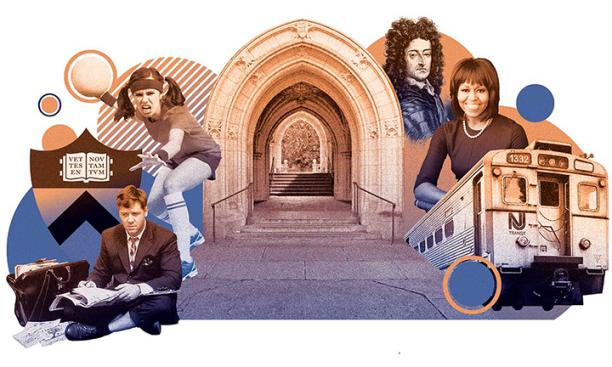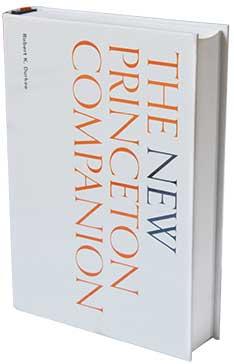
The definitive encyclopedia of all things Princeton, A Princeton Companion, was written in the 1970s. Sooner or later, the ever-flowing current of time, as F. Scott Fitzgerald 1917 described it, had to be acknowledged. This month sees the publication of The New Princeton Companion (Princeton University Press), a vastly updated and expanded edition for the readers of today.
The task of writing a compendium dedicated to a university is audacious, maybe foolhardy, because universities are in the business of producing knowledge: Nobody could ever stagger to the top of the mountain of art, books, discoveries, laws, patents, technologies, and more that Princeton’s denizens and alumni produce every year. Nonetheless, 50 years is enough time to demand a new history. The University is making, today, more efforts to address ugly parts of its history that earlier administrations may have wanted to keep buried. The student body is more diverse, and so is the alumni community. Historical avenues that didn’t seem worth exploring at length in the ’70s — Computers? Those big industrial appliances that only specialists ever see? — have become superhighways of the modern world. And on top of all that, Princeton has continued to make new history.
The editor of The New Princeton Companion, Robert Durkee ’69, is a former vice president and secretary of the University. As someone who attended Princeton as an undergraduate, covered it for The Daily Princetonian, and then spent more than 47 years as an administrator in Nassau Hall, Durkee thought, when he started work on the book, that he knew the University’s history fairly well. Nonetheless, he said, “I certainly came away from the project with a more textured, more expansive view of the University.”
The book opens with longform essays on the history of the University, the history of the changing physical campus, and the University’s informal motto, “Princeton in the nation’s service and the service of humanity.” It also includes a calendar that lists an event in Princeton’s history for every day of the year.
“The idea of the calendar came late,” Durkee said. “I tell you, the month of August was a challenge. For an institution that operates on an academic calendar, not much happens in August.”
Interesting tidbits about Princeton’s history abound in the book’s pages. Jonathan Belcher, an 18th-century governor of New Jersey, gave such generous support to the University (the College, at the time) that the trustees proposed to give the name Belcher Hall to what is now Nassau Hall. Belcher suggested the name Nassau Hall instead, after King William III of the House of Nassau. From there, by way of our baseball team and a student named George Ward 1869, who petitioned mightily for the College to have colors as other schools did, came the school colors of orange and black, inspired by the colors of the House of Nassau. (Belcher’s coat of arms featured stripes of yellow and red; had we gotten Belcher Hall, we might today have the same colors as McDonald’s.)
More: Nathaniel FitzRandolph, an 18th-century Quaker whose grandson donated the funds for FitzRandolph Gate, lies buried with his family under the archway of Holder Hall. … During the Civil War, the University alienated a generation of Southern alumni by loudly declaring allegiance to the Union. … During the Great Dinky Robbery of 1963, students on horseback, wearing cowboy hats and bandana masks, stopped the Dinky en route to Princeton and spirited train passengers away to the eating clubs. The roll of Princetoniana extends seemingly forever: Dean’s Date, the Dillon dodgeball tournament (inaugurated 2005), the “Dirty Bicker” of 1958 (when, shamefully, the eating clubs refused to admit a large group of Jewish students).
New or expanded content includes entries on Jewish, Black, and Hispanic/Latinx students at Princeton; the Frist Campus Center; the University’s pioneering history in computing; the historic case on the Deferred Action for Childhood Arrivals (DACA) program that Ramona Romero, the University’s general counsel, helped to win at the U.S. Supreme Court; Toni Morrison; Michelle Obama ’85; entrepreneurship and innovation on campus; pranks; “Princeton in the Movies and on Television”; Sally Frank ’80’s successful fight to win admission for women into all eating clubs; and LGBTQIA students at Princeton. An entry on “Epidemics” was motivated by the COVID-19 pandemic.
The book faithfully honors the names of many major donors. John Insley Blair, a railroad baron whose generosity built Blair Hall in 1897, remarked, upon becoming a University trustee, that “his own formal education was limited; he had spent most of his life learning addition and now, he said, ‘I have come to Princeton to learn subtraction.’” An entry on Cyrus Fogg Brackett, a brilliant eccentric in the science faculty, comes with a story about three of his students — David B. Jones 1876, Thomas D. Jones 1876, and Edgar Palmer 1903 — whose fond memories of their teacher led to the creation of Jones Hall and Palmer Physical Laboratory.
All of which is right and proper, given that, as The New Princeton Companion records, the official list of “Princeton University’s Defining Characteristics and Aspirations” ends with this: “an intensely engaged and generously supportive alumni community.” Take note, dear reader.

